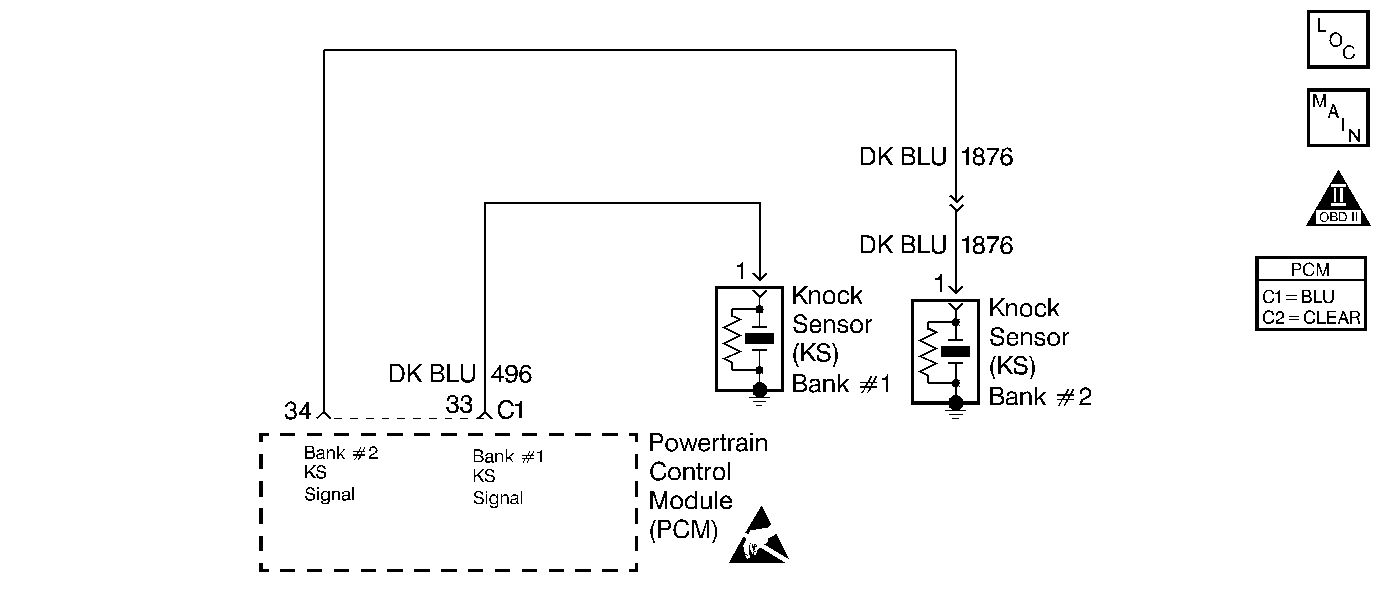
Circuit Description
The PCM contains integrated Knock Sensor (KS) diagnostic circuitry. Input signals from the knock sensors are used to detect engine detonation, allowing the PCM to retard Ignition Control (IC) spark timing based on the amplitude and frequency of the KS signal being received. The knock sensors produce an AC signal under all engine operating conditions. During engine operation, the PCM calculates the average voltage of each knock sensor's signal. If the knock sensor system is operating normally, the PCM should monitor KS signal voltages varying over 0.5 volt above and below the calculated average voltage. If the PCM detects a Knock Sensor 2 signal voltage within the calculated average voltage range, DTC P0332 will set.
Conditions for Running the DTC
| • | No TP sensor, VSS, CKP, MAF or ECT sensor DTCs set. |
| • | Engine coolant temperature is greater than 75°C (167°F). |
| • | Throttle angle is greater than 3 percent. |
| • | Engine load is greater than 20 percent. |
| • | Engine speed is between 1000 and 4000 RPM. |
| • | Maximum system spark retard is less than 15 degrees. |
| • | System voltage is greater than 9 volts. |
Conditions for Setting the DTC
The PCM detects a Knock Sensor 2 signal voltage within the calculated average range.
Action Taken When the DTC Sets
| • | The PCM will not illuminate the Malfunction Indicator Lamp (MIL). |
| • | The PCM will store conditions which were present when the DTC set as Fail Records data only. This information will not be stored as Freeze Frame data. |
| • | The PCM will use a calculated spark retard value to minimize knock during conditions when knock is likely to occur. The calculated value will vary based on engine speed and load. |
Conditions for Clearing the MIL/DTC
| • | A history DTC P0332 will clear after 40 consecutive warm-up cycles have occurred without a fault. |
| • | DTC P0332 can be cleared by using the scan tool Clear Info function or by disconnecting the PCM battery feed. |
Diagnostic Aids
Check for the following conditions:
| • | Poor connection at the PCM or Knock Sensor 2. |
| Inspect knock sensor 2 and PCM connectors for backed out terminals, broken locks, and improperly formed or damaged terminals. |
| • | Misrouted harness. |
| Inspect the knock sensor harness to ensure that it is not routed too close to high voltage wires such as spark plug leads. |
Reviewing the Fail Records vehicle mileage since the diagnostic test last failed may help determine how often the condition that caused the DTC to be set occurs. This may assist in diagnosing the condition.
Test Description
Numbers below refer to the step numbers on the Diagnostic Table.
-
Ensures that the malfunction is present.
-
If sent here from symptoms, proceed with the diagnostic table.
Step | Action | Values | Yes | No |
|---|---|---|---|---|
1 | Was the Powertrain On-Board Diagnostic (OBD) System Check performed? | -- | ||
Important: If a mechanical engine knock can be heard, repair the engine mechanical problem before proceeding with this diagnostic. Refer to Engine Noise Diagnosis .
Does scan tool indicate DTC P0332 failed this ignition? | -- | |||
Does the scan tool indicate DTC P0332 failed this ignition? | -- | Go to Diagnostic Aids | ||
4 |
Was problem found? | -- | ||
5 |
Was problem found? | -- | ||
6 | Replace the knock sensor. Refer to Knock Sensor Replacement . Is action complete? | -- | -- | |
7 |
Does the scan tool indicate DTC P0332 failed this ign? | -- | System OK |
